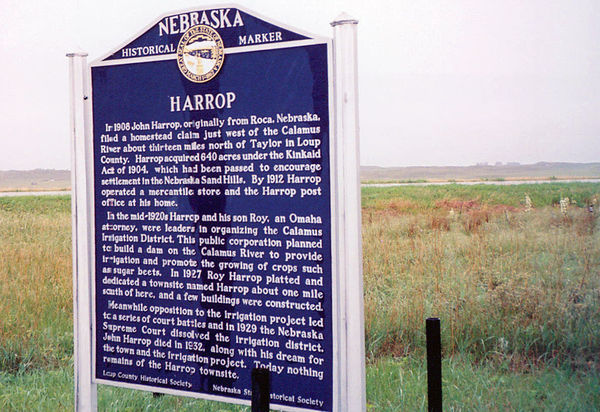Difference between revisions of "Nebraska Historical Marker: Harrop"
| Line 2: | Line 2: | ||
==Location== | ==Location== | ||
| − | + | U.S. 183, 18 miles north of Taylor, Loup County, Nebraska | |
View this marker's location '''[https://maps.google.com/maps?q=42.013533,+-99.45528&hl=en&sll=41.907537,-99.29943&sspn=0.054615,0.111494&t=h&z=14 42.013533, -99.45528]''' | View this marker's location '''[https://maps.google.com/maps?q=42.013533,+-99.45528&hl=en&sll=41.907537,-99.29943&sspn=0.054615,0.111494&t=h&z=14 42.013533, -99.45528]''' | ||
| Line 9: | Line 9: | ||
==Marker Text== | ==Marker Text== | ||
| − | ''In 1908 John Harrop, originally from Roca, Nebraska, filed a homestead claim just west of the | + | ''In 1908 John Harrop, originally from Roca, Nebraska, filed a homestead claim just west of the Calamus River about thirteen miles north of Taylor in Loup County. Harrop acquired 640 acres under the Kinkaid Act of 1904, which had been passed to encourage settlement in the Nebraska Sand Hills. By 1912 Harrop operated a mercantile store and the Harrop post office at his home. |
| − | Calamus River about thirteen miles north of Taylor in Loup County. Harrop acquired 640 acres | + | |
| − | under the Kinkaid Act of 1904, which had been passed to encourage settlement in the Nebraska | + | ''In the mid-1920s Harrop and his son Roy, an Omaha attorney, were leaders in organizing the Calamus Irrigation District. This public operation planned to build a dam on the Calamus River to provide irrigation and promote the growing of crops such as sugar beets. In 1927 Roy Harrop platted and dedicated a townsite named Harrop about one mile south of here, and a few buildings were constructed. |
| − | Sand Hills. By 1912 Harrop operated a mercantile store and the Harrop post office at his home. | + | |
| − | In the mid-1920s Harrop and his son Roy, an Omaha attorney, were leaders in organizing the | + | ''Meanwhile opposition to the irrigation project led to a series of court battles and in 1929 the Nebraska Supreme Court dissolved the irrigation district. John Harrop died in 1932, along with his dream for the town and the irrigation project. Today nothing remains of the remains of the Harrop townsite. |
| − | Calamus Irrigation District. This public operation planned to build a dam on the Calamus River | + | |
| − | to provide irrigation and promote the growing of crops such as sugar beets. In 1927 Roy Harrop | + | |
| − | platted and dedicated a townsite named Harrop about one mile south of here, and a few buildings were constructed. | + | |
| − | ''Meanwhile opposition to the irrigation project led to a series of court battles and in 1929 the | + | |
| − | Nebraska Supreme Court dissolved the irrigation district. John Harrop died in 1932, along with | + | |
| − | his dream for the town and the irrigation project. Today nothing remains of the remains of the | + | |
| − | Harrop townsite. | + | |
==Further Information== | ==Further Information== | ||
Latest revision as of 10:51, 29 September 2017
Location
U.S. 183, 18 miles north of Taylor, Loup County, Nebraska
View this marker's location 42.013533, -99.45528
View a map of all Nebraska historical markers, Browse Historical Marker Map
Marker Text
In 1908 John Harrop, originally from Roca, Nebraska, filed a homestead claim just west of the Calamus River about thirteen miles north of Taylor in Loup County. Harrop acquired 640 acres under the Kinkaid Act of 1904, which had been passed to encourage settlement in the Nebraska Sand Hills. By 1912 Harrop operated a mercantile store and the Harrop post office at his home.
In the mid-1920s Harrop and his son Roy, an Omaha attorney, were leaders in organizing the Calamus Irrigation District. This public operation planned to build a dam on the Calamus River to provide irrigation and promote the growing of crops such as sugar beets. In 1927 Roy Harrop platted and dedicated a townsite named Harrop about one mile south of here, and a few buildings were constructed.
Meanwhile opposition to the irrigation project led to a series of court battles and in 1929 the Nebraska Supreme Court dissolved the irrigation district. John Harrop died in 1932, along with his dream for the town and the irrigation project. Today nothing remains of the remains of the Harrop townsite.
Further Information
Bibliography
Elton A. Perkey, “Perkey’s Nebraska Place Names” (1995), Nebraska State Historical Society
Marker program
See Nebraska Historical Marker Program for more information.
